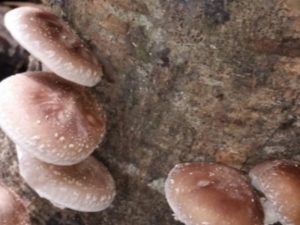

Small Scale Shiitake Mushroom Production: a TASTY and SAFE backyard project
If you are a mushroom fancier, you have at one time or another probably considered or even taken part in the harvesting of edible wild fungi. This is a common practice by many people and quite often there are a few “foolproof” species in the area where you live that will provide safe table fare and enjoyment during the hunt. However, oft-times wild mushroom harvesters take a notion to branch out and seek new varieties that are outside of the “foolproof” identification capabilities of the novice mycologist. This is where you begin treading on dangerous ground and may be at risk for gastrointestinal distress, ranging from a mild upset to permanent damage or death.
Yes, death! Everyone has heard about poisonous mushrooms but few people realize that some of the deadliest species are look-alikes for some of the tastiest species. And you would not be able to distinguish the difference by nibbling a sample. Even a small sample of some of the “bad actors” can be lethal, leading to painful symptoms and organ failure. If this scares you out taking a risk then this article has served a good purpose.
If you want to enjoy a safe, tasty experience with a highly-prized species, why not take up the hobby of growing your very own shiitake mushrooms. Shiitake comes from the root Japanese “shii” (meaning oak) and “take” (for mushroom). Shiitake mushrooms are a billion dollar industry in Asia with 92% of the world production coming from Japan. Many culinary and medical uses have been identified. This species was only available as dried mushrooms in the US until 1972 but with the removal of a ban on importing live fungi a commercial industry has blossomed rapidly.
Hardwood logs are the key, with oak being a preferred tree species.
There are six key considerations if you are to be successful growing Shittake mushrooms:
- Acquiring living Shiitake inoculum (the mycelial or rooting stage) already growing on a wood medium, usually hardwood dowels or sawdust. Many providers are available via the internet.
- Proper cutting and handling of the logs to be inoculated. Trees need to be cut close to the time of inoculation (2 weeks max.) and be 4-8 inches thick and 3-4 feet long.
- Inoculation takes place by drilling holes in the logs, inserting the living inoculum/spawn and sealing the holes with melted wax to retain moisture in the wood. A single log may have 30-40 holes drilled.
- Logs are to be placed in a shady/moist environment (i.e. under the canopy in a woodlot with at least 75% shade).
- Maintenance of logs may require wetting during dry spells.
- Proper harvesting and storage is most important and information is available in many places online.
Shiitake fruiting is generally triggered by changes in temperature and humidity so spring and fall are key times to check your logs. It does not take long for a mushroom to go from the early “pinning” stage to beyond a usable product so weekly checks are advised. Significant tropical weather events like Hurricane Irma will also stimulate fruiting. Logs will produce mushrooms for at least two seasons, until the nutrients in the wood are used up, making the logs feel much lighter and softer.
Don’t be in a big hurry though, to start enjoying the fruits of your labors as the full colonization of the log by the mushroom mycelium (the spawn run) will take up to 9 months before mushrooms appear. Your local county Extension office can provide you with more information regarding growing shiitake mushrooms and there are two upcoming workshops scheduled; one for Eastpoint on February 17, and another for Port St. Joe on February 24. Participants will get more detailed information and also inoculate a log or two to take home. Remember, beware the risks associated with harvesting wild fungi; a shiitake log is a safer alternative. You may, however, have to do battle with a squirrel or two as they know a good thing when they see it too.
 2
2

Comments:
January 31, 2018
Please contact UF IFAS Gulf County at 850-639-3200 and welcome.
January 19, 2018
Hi we moved here recently and i have started growning oyster mushrooms in the house. I would really like to attend your shittake mushroom program. How do I get registered? I live in Port St Joe
Comments are closed.